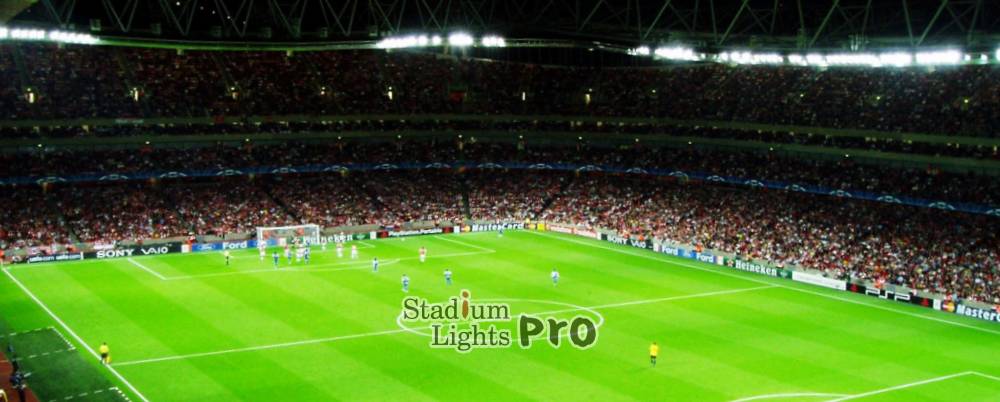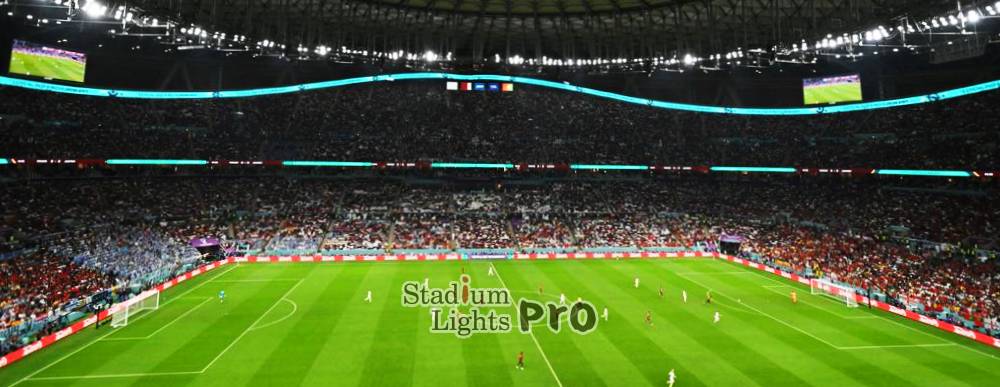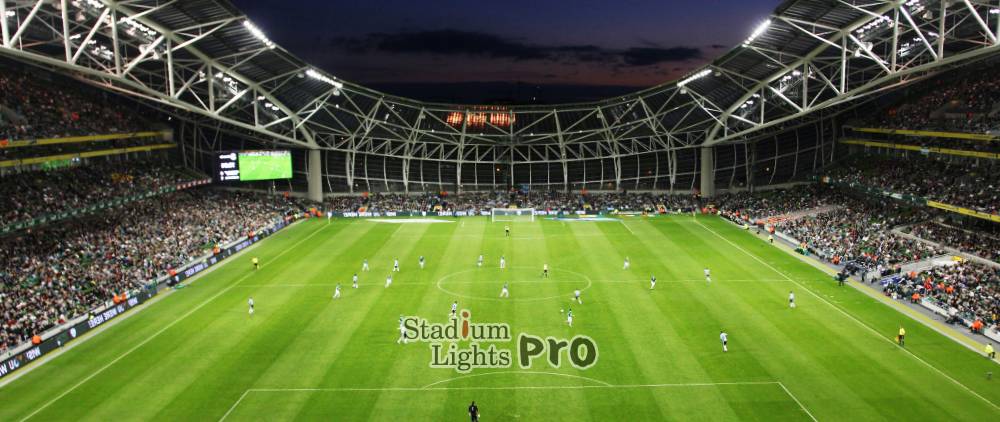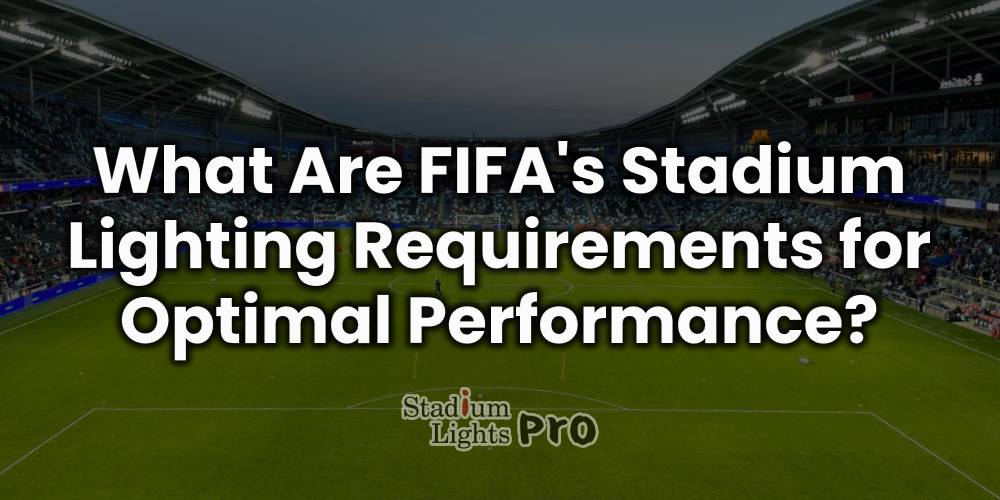Table of Contents
ToggleFIFA Lighting Categories and Their Purpose
FIFA has established a classification system for stadium lighting that varies according to the competition level, stadium size, and broadcasting needs. These categories—Category 1, Category 2, Category 3, and Elite Level—serve to ensure the appropriate level of illumination for players, spectators, and broadcasters. Each category has a distinct illuminance standard to ensure the optimal environment for the various needs of the event.
Category 1 is intended for lower-division matches or training grounds where broadcasting is minimal. These matches may be regional or amateur competitions, and the illuminance levels required typically range from 500 to 1000 lux. Category 2 applies to national and regional competitions with moderate media coverage. The illuminance required for these events is approximately 1000 to 1500 lux. The lighting must be sufficient to provide a clear, well-lit environment for broadcast cameras, officials, and players.
Category 3 is reserved for international competitions and matches that are broadcast globally. The required illuminance for this category generally ranges from 1500 to 2000 lux, ensuring the visual quality for high-definition broadcasting is maintained. Elite Level lighting, the highest standard, is required for prestigious events such as the FIFA World Cup and other major international tournaments. The illuminance for these events must exceed 2000 lux, often reaching up to 3000 lux, to meet the demands of ultra-high-definition broadcasts and multiple camera angles.
| Lighting Category | Illuminance (Lux) | Event Type | Description |
|---|---|---|---|
| Category 1 | 500 – 1000 lux | Lower-division matches, training grounds | For training or local matches with minimal media coverage |
| Category 2 | 1000 – 1500 lux | National/regional competitions | Matches with moderate media and broadcast requirements |
| Category 3 | 1500 – 2000 lux | International events | High-quality illumination for global broadcasts and competitive events |
| Elite Level | 2000 – 3000 lux | FIFA World Cup, major international events | Top-tier lighting for ultra-high-definition broadcasts and global viewing |

Adaptation for Different Competitions
Stadiums hosting a variety of competitions must have adaptable lighting systems. These systems are designed to provide varying levels of brightness based on the nature of the event. LED lights have become increasingly popular due to their adjustability, energy efficiency, and ability to provide even light distribution without any warm-up period. They offer significant advantages, particularly for broadcast purposes, where flicker-free lighting and color accuracy are crucial.
During major events like the FIFA World Cup, temporary upgrades are often implemented to meet the requirements for Elite Level lighting. These adjustments ensure that the lighting system can easily switch from lower-intensity settings for training sessions or local matches to the high-output levels required for international broadcasts.
Types of Lights Used in Stadiums
LED Lighting
LED lighting technology has revolutionized stadium lighting. Unlike traditional lighting methods, LEDs are highly energy-efficient, long-lasting, and capable of offering highly controlled brightness levels. LED lights generate minimal heat and can produce a range of color temperatures, which is essential for both player performance and broadcast clarity.
An LED floodlight used in a stadium can consume between 300 and 1000 watts, depending on the required illumination levels. These lights are capable of producing over 100,000 lumens per fixture, offering bright, flicker-free light that is perfect for television broadcasts. Moreover, they have a lifespan of up to 50,000 to 100,000 hours, significantly reducing maintenance costs.
Metal Halide Lighting
Although metal halide lamps have been used for decades in stadiums, their popularity is waning in favor of LED lighting. Metal halide lamps are known for their high-intensity light output, capable of producing around 100,000 to 150,000 lumens per fixture, but they are less energy-efficient than LEDs and require a longer warm-up period—sometimes up to 15 minutes. Their lifespan is significantly shorter than LEDs, averaging around 15,000 to 20,000 hours.
Despite these drawbacks, metal halide lamps are still used in older stadiums that have not transitioned to LED systems. The energy consumption for a metal halide lamp ranges from 1,000 to 2,000 watts, leading to higher operational costs.
Hybrid Lighting Solutions
Some modern stadiums utilize a hybrid lighting system that combines both LED and metal halide lights. This hybrid approach seeks to balance the superior energy efficiency and longevity of LEDs with the high-intensity output of metal halide lights. The hybrid system might use LED lights for general lighting and metal halide lights for specific lighting requirements, such as bright spotlights or specialized visual effects during broadcast events.
The hybrid system allows for flexibility in lighting control, ensuring that operational costs are reduced while still meeting FIFA’s strict lighting standards. For example, an average hybrid system might use 400-800 watts per LED fixture and 1,500-2,500 watts per metal halide fixture.

Comparison of Types of Lights Used in Stadiums
| Feature | LED Lighting | Metal Halide Lighting | Hybrid Lighting Solutions |
|---|---|---|---|
| Energy Efficiency | Highly energy-efficient, reduces operational costs | Less energy-efficient, higher consumption | Balances energy efficiency of LEDs with high output of metal halide lights |
| Lifespan | 50,000 – 100,000 hours | 15,000 – 20,000 hours | Varies based on the mix of LED and metal halide lamps used |
| Illuminance Output | 100,000 – 120,000 lumens per fixture | 100,000 – 150,000 lumens per fixture | Varies depending on the ratio of LEDs and metal halides used |
| Startup Time | Instant on/off, no warm-up required | Requires 5-15 minutes for full brightness | Instant on/off for LEDs, slower startup for metal halide lamps |
| Flicker-Free | Flicker-free operation, ideal for broadcasting | Can flicker, not ideal for high-definition broadcasts | Flicker-free for LEDs; potential flickering from metal halides |
| Glare Control | Superior glare control with advanced optics | Can produce significant glare | Offers glare control with LEDs, while metal halides require additional measures |
| Color Rendering | High CRI, typically >80, ensuring accurate colors | Moderate CRI, can distort colors | Combines the CRI benefits of LEDs with the intense light of metal halides |
| Maintenance | Low maintenance due to long lifespan | Requires frequent replacement and maintenance | Reduced maintenance compared to pure metal halide systems, but still needs some upkeep |
| Environmental Impact | Low carbon footprint, reduced energy use | Higher carbon footprint, more energy consumption | Lower environmental impact than metal halide alone, higher than pure LEDs |
Standards for Stadium Lights
Illuminance and Uniformity
FIFA has set precise illuminance levels (measured in lux) for various types of events to ensure that visibility and performance are optimal. The illuminance required depends on the competition level. Training sessions generally require about 500 lux of lighting, whereas national and regional matches require 1000 to 1500 lux. International competitions typically call for illuminance between 1500 and 2000 lux, and elite events, such as the World Cup, require more than 2000 lux, often reaching up to 3000 lux.
In addition to the illuminance levels, FIFA also mandates a uniformity ratio. The uniformity of lighting, expressed as a ratio of minimum to average illuminance, should not fall below 0.7:1 for Category 1 and Category 2 events, and 0.8:1 for higher-level competitions. This ensures there are no dark or overexposed spots on the playing field, providing clear visibility for players, spectators, and broadcasters.
Glare Control and Flicker-Free Lighting
Glare can seriously detract from the performance of players and disrupt the viewing experience. Therefore, FIFA emphasizes that lighting systems must include effective glare-control measures. The lighting fixtures are typically equipped with advanced optics, anti-glare shields, and precise mounting angles to reduce direct glare from players’ and spectators’ perspectives.
Flicker-free lighting is crucial for broadcasting, especially when it comes to high-definition video and slow-motion replays. Modern LED lights are engineered to operate without flicker, ensuring a smooth, stable image on broadcast feeds. This capability is particularly important for 1080p or 4K UHD broadcasts, where even minor flickering can create visual distortions.
Color Rendering Index (CRI)
The Color Rendering Index (CRI) is a measure of how well a light source reproduces the colors of objects compared to natural daylight. FIFA recommends a minimum CRI of 80 for all lighting systems used in stadiums. A CRI of 80 ensures that colors—such as players’ uniforms, the ball, and the field—are accurately represented on television broadcasts, which is essential for viewers.
Higher CRI values (up to 90 or 95) can be used for elite-level competitions, where visual fidelity is critical. High-quality lighting ensures that the colors are vivid, and the broadcast is clear and accurate.
Measurement of Distance and Positioning of Lights
Optimal Height and Angle
The proper positioning of lighting fixtures is crucial to ensure uniform illumination across the playing field and to minimize shadows. According to FIFA guidelines, lights should be mounted at a height between 30 meters and 50 meters above the pitch, depending on the size of the stadium and the type of event.
The angle at which lights are positioned is equally important. For example, lights are typically angled between 45 and 60 degrees from the ground. This reduces shadows caused by players’ movements and ensures that the field is uniformly lit, preventing areas from being too bright or too dark.
Distribution of Fixtures
The arrangement of lighting fixtures in a stadium is a key factor in ensuring consistent illumination. Typically, fixtures are mounted along the sides of the stadium or on masts that are placed around the perimeter. For smaller venues, corner lights can be sufficient, while larger stadiums require more fixtures to cover all areas of the field.
A general recommendation for spacing between fixtures is 10 to 20 meters, though this can vary based on the fixture’s power output and the stadium’s dimensions. The lighting system is designed to ensure that there are no dark zones, and the uniformity ratio is maintained.
Mathematical Modeling and Simulation
Before the actual installation of the lighting system, engineers use sophisticated computer-aided design (CAD) software to simulate light distribution, glare, and shadow patterns. These simulations allow the team to make precise adjustments to the number, placement, and type of lights before construction begins.

Design Considerations for Stadium Lighting
Structural Support
Stadium lighting fixtures are typically mounted on robust structures, such as steel masts or reinforced concrete beams. These structures are designed to withstand various environmental factors, such as wind loads, vibrations, and extreme weather conditions.
For stadiums with retractable roofs, special mounting systems are used to ensure that the lights remain stable, even as the roof moves. These mounting systems are often engineered to allow for slight adjustments in the height or angle of the lights during roof retraction.
Aesthetics and Architectural Integration
Modern stadiums are designed with both functionality and aesthetics in mind. In many cases, lighting systems are integrated into the architecture of the stadium to provide a sleek and visually appealing appearance. Fixtures are often concealed within the roof or behind translucent panels, enhancing the overall aesthetic while still delivering high-performance lighting.
Environmental Impact and Sustainability
The growing concern for sustainability has led many stadiums to adopt LED lighting systems. These systems are not only energy-efficient but also environmentally friendly, as they reduce overall energy consumption and decrease carbon emissions. Some stadiums are even integrating solar panels or wind power to supplement their electricity needs, further reducing their environmental footprint.
Smart lighting systems are another major development, as they allow operators to adjust the brightness and power usage based on the real-time needs of the event. This dynamic approach can lead to significant energy savings, especially during less intensive events.
Conclusion
FIFA’s lighting standards, which are categorized into different levels based on the competition and event requirements, emphasize the importance of uniformity, brightness, and color accuracy to deliver high-quality experiences. The shift from traditional metal halide lighting to more energy-efficient LED systems is a testament to the evolving nature of stadium design and technology, meeting the increasing demands of modern broadcasting and environmental considerations.
The careful planning of light positioning, combined with advanced simulation tools, ensures that every stadium provides the ideal lighting conditions, minimizing glare and shadows while maximizing visibility. Furthermore, hybrid lighting solutions offer a versatile approach for venues looking to balance cost and performance, allowing for adjustments as necessary for different types of events.
Beyond technical specifications, stadium lighting is also about creating an atmosphere that enhances the spectator experience and supports player performance. As sustainability becomes a growing concern, many stadiums are incorporating energy-efficient technologies, such as smart lighting and renewable energy sources, to reduce their environmental impact.
In the end, FIFA’s rigorous lighting standards not only guarantee a superior visual experience but also ensure safety, fairness, and accessibility for all involved. As lighting technology continues to evolve, stadiums that embrace these innovations will remain at the forefront of global sporting events, providing the best conditions for players, broadcasters, and fans alike.

